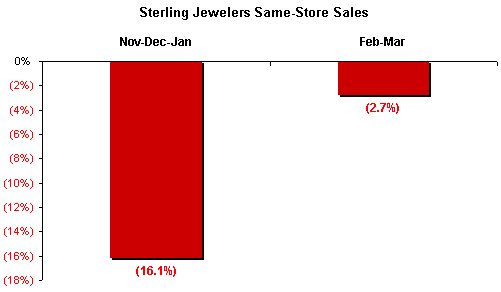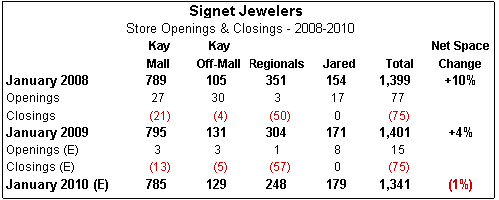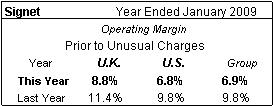IDEX Online Research: Sterling Jewelers Posts Encouraging Results
April 06, 09
Like most jewelers, Sterling Jewelers, the U.S. division of Signet Jewelers Ltd, posted disappointing results for its fourth quarter and full fiscal year ended January 2009. However, when compared to most of its competition, Sterling’s results were better than the average of the group.
The real news, though, concerns sales trends in the first fiscal quarter (February-April) of this year: after seven weeks, same-store sales are down by only 2.7 percent. This is in dramatic contrast to other jewelers who have reported first quarter sales trends that are down high single-digit levels or even double-digit levels. Further, it is an encouraging trend from the fourth quarter when Sterling reported that its same-store sales were down 16 percent. The graph below illustrates the disparity in same-store sales between the Sterling’s fourth fiscal quarter (November-January) and the past seven weeks of February and March 2009.

Source: Company Reports
Another good sign: Sterling’s gross merchandising margin is “meaningfully up”, according to management, due to price increases implemented in early calendar 2008 as well as favorable sales mix changes primarily related to an increase in sales of proprietary and exclusive merchandise. These positive factors have been enough to offset the rising price of gold. Clearly, Sterling is doing something right.
How does Sterling buck the trend?
Several factors have helped Sterling to post better-than-average results. On a recent call with Wall Street analysts, Sterling’s management went into detail about its strategies to offset the negative impact of the current recessionary economy.
- Sterling has increased its sales mix of proprietary and exclusive merchandise such as the Leo Diamond as well as branded goods from Le Vian and Jane Seymour. This has helped create the impression among consumers that Sterling’s stores have something new and different. Further, it has helped boost the company’s gross margin.
- The company has focused on improvements to its jewelry repair services, which is an important driver of customer traffic.
- One of the company’s primary goals is to maximize gross merchandise margin dollars. This will help cover operating costs more efficiently.
- Management noted that in the current environment, the lowest risk strategy to grow profitable market share is to focus on sales productivity in existing stores primarily to existing customers.
- Employee training has been focused on product knowledge and developing selling skills appropriate for a more challenging marketplace. Sales people have been trained on how to communicate the value of the merchandise selected, followed by a strong “close the sale” message.
- Enhanced in-store technology has reduced administrative burdens and improved the efficiency of store, district and regional management.
- Store staff hours were reduced. Overhead staffing levels have decreased through attrition.
- Marketing costs were selectively reduced last year, a trend which continues this year. Spending is concentrated in the most productive channels, with a focus on the most productive store brands – primarily Kay and Jared. For the full fiscal year ended January 2009, gross marketing spend was down 7.6 percent to about 7.4 percent of sales in 2008, about in line with prior years (7.5 percent in 2007). Television was the medium of choice; radio was reduced significantly.
- E-commerce was added to the company’s website.
- Sterling’s credit sales on its own in-house credit program represented 53.2 percent of total sales, up marginally from 52.6 percent in the prior year. This increase came despite a larger number of rejected credit applications (about 300 basis points higher) and an increase in delinquent accounts which generated a higher level of bad debt. Bad debt was 4.9 percent of total sales (or about 9.2 percent of credit sales), up from 3.4 percent in the prior year, a level that was representative of the past ten years.
Sterling has used credit selectively to meet the needs of more creditworthy customers, but the company did not use it indiscriminately with customers who might have had a propensity to fail to pay the account off. In an effort to help minimize losses, Sterling has raised the amount of down-payments certain customers must make. It has implemented revised scoring models and improved its collection strategies.
- New store openings have been curtailed. Last year, net store space increased by about 4 percent, down from a 10 percent expansion in the prior year. We look for no new net store space increase this year. The table below summarizes store openings and closings last year as well as projected store expansion in 2009.

- Management is rigidly enforcing its policy that a new store location must achieve a 20 percent internal rate of return. Unfortunately, much of the excess (read: “cheap”) real estate in the market will probably never be capable of producing those returns for Sterling. Thus, we look for the company to be increasingly selective about its new store locations.
- The company has changed its vacation policy which will result in a one-time savings of $13 million.
- Slow moving inventory is being eliminated, and inventory will be refocused on goods that are selling. About $90 million of inventory is targeted to be cut; buyers’ “open-to-buy” allocations have been reduced. Sterling is focusing on GMROI (Gross Margin Return on Investment), a concept that far too few jewelers understand. Finally, the company will eliminate its remaining rough diamond inventory.
- The company is also seeing some competitive relief from those jewelers who have liquidated their goods and closed stores such as Whitehall and Friedman’s. The reduction in industry capacity – 1,500 to 2,000 stores have exited the market over the past year or so, a reduction of nearly 7 percent – so Sterling is focusing on picking up market share from failed competitors.
- Sterling is renegotiating store leases to reduce rents. It is having the most success with those leases which have only a short time to run.
- Sterling has a marketing strategy aimed at retaining customers who formerly shopped at stores that it is closing. The strategy is called “transfer sales.” The program is aimed at recapturing those former customers.
Other Highlights of Sterling’s Fourth Quarter and Full Year
The following table summarizes Signet Jewelers’ sales trends for the fourth quarter. Other financial information is not shown because of the impact of the one-time charges in the final period of the year.

- Sterling’s fourth quarter same-store sales fell by 16.1 percent. For the full year, same-store sales retreated by 9.7 percent. New space added 3.4 percent to sales, less than in prior years when the company’s new store expansion program was larger.
- Sterling management noted that sales in its Jared division, which caters to higher income consumers, were weaker in the fourth quarter than sales in its mall stores.
- For the full year, the average unit selling price was flat versus the prior year (the company has not yet disclosed the average unit selling price, but it will be reported in its legal filings by the end of this month). During the first nine months of last year, the average unit selling price was up 7 percent, with mall brands up 7 percent and Jared up 5 percent (prior to the impact of the new charm bracelets in Jared stores).
- Sales of bridal jewelry declined by a smaller amount than the company average. Bridal is a recession-resistant product category. For Sterling, it represents 45-50 percent of total sales. The Leo Diamond collection also performed better than average.
- Sterling launched new exclusive product, including specially designed collections such as Open Heart by Jane Seymour and jewelry from Le Vian. These product categories performed well.
- This year, Sterling’s management expects its gross merchandise margin to be at least flat – if not higher – than last year, with the increase in the price of gold offset by supply chain efficiencies, especially related to the sourcing of diamonds. Further, in the first quarter, there will be some benefit from price increases implemented early last year as well as continuing favorable sales mix changes.
- Over the past two years, the number of Sterling’s regionally branded stores has dropped from about 350 to a projected 250 at the end of this year. At one point, management had planned to create a second national brand with its regional stores. However, this did not prove feasible. Further, the regional branded stores are less productive and less profitable than the Kay brand. Management attributes this to the lack of national media advertising to create consumer awareness.
Signet Jewelers Results
Signet Jewelers (formerly Signet Group) is the owner of Sterling Jewelers (1,400+ stores) in the U.S., as well as the owner of almost 560 jewelry stores in the United Kingdom. The following are highlights from consolidated corporate financial results for the year ended January 2009.
- The table below shows that Signet Jewelers posted an operating profit before special charges for the full year, though it was down from the prior year.
 |
- Signet’s financial results for the full fiscal year ended January 2009 were distorted by two one-time items:
- Fair value impairment of goodwill of $517 million – This was totally a non-cash charge, and represents the write-off of all the goodwill on the company’s balance sheet. U.S. GAAP encourages companies to write off goodwill, but it hurts shareholder equity.
- Cost of change of domicile and primary stock listing – Signet moved from its U.K. based domicile to Bermuda. Further, it moved its primary listing from the London Stock Exchange to the New York Stock Exchange. These moves cost the company about $10.5 million. Even though these moves should benefit the company over the long term, it was a significant cost by any measure.
- In an effort to conserve cash, Signet’s board has decided not to pay cash dividends during the current year.
- Because of deteriorating conditions in the credit market, Signet restructured its debt earlier this year. Essentially, the new debt agreements provide more financial flexibility in the medium term while allowing the company to repay some of its debt near term.